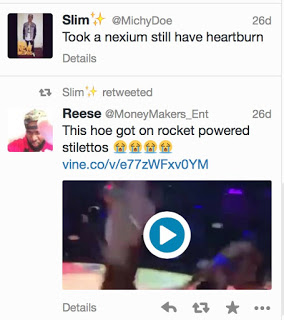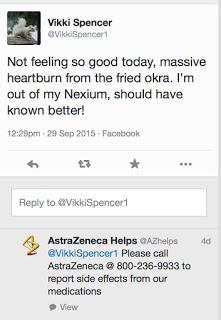@AZHelps was featured in a “Customer Service Fireside Chat,” which focused on opportunities for pharma to “build a stronger relationship between Marketing/Communications and Customer Service, perhaps even driving additional revenue and better health outcomes.”
Leigh Householder (innovation officer at GSW and the editor of the Health Experience Project) wrote a glowing report, which summarized how @AZHelps supposedly works:
“AstraZeneca has been investing in supporting people via social media for 6 years. Their goal is to educate patients about available resources (including cost, access, affordability) and to address specific product inquiries.
“AZhelps uses Hootsuite to listen for comments about their products. When they see a comment that meets their engagement criteria, they respond. Clear rules of engagement mean they don’t respond to every tweet they see.
“They’ve built their social support system right in the call center with someone (Heather!) who is experienced addressing customer questions and is scheduled and dedicated to the task.”
I find it hard to believe, however, that @AZHelps drives revenue or better outcomes or that it even marginally helps people. Read on to find out why…
First, @AZHelps has only posted about 1200 tweets in 6 years – that’s about 1 tweet every 2 days. That’s not a lot of work for Heather. Also, I’m sure it’s all robotic in any case – Heather just has to push a button to tweet or not to tweet a response.
Second, practically every tweet has the same message – “Please call AstraZeneca @ 800-236-9933 to report side effects from our medications” or “Questions? Call AstraZeneca maker of NEXIUM® (esomeprazole magnesium) @ 800-236-9933”
Who’s going to call an 800 number? Nobody, that who. Why not have a link to actually educational content on the Web? Or a link to the promised coupon or cost savings deal? Nope – just call the 800 number! It appears that @AZHelps is just an attempt to funnel more calls into the call center for some unknown reason.
Third, these tweets are sent to people 1 or 2 days AFTER the original comment was made, which is not very engaging.
Let’s look at a couple of recent tweets that met @AZHelps “engagement criteria.”
@Michydoe (aka “Slim”) tweeted he still had heartburn after taking nexium:
@AZHelps responded a day later: “@Michydoe Please call AstraZeneca @ 800-236-9933 to report side effects from our medications” I’m sure “Slim” did not call because he, unlike AZ, realized that a non-effect does not qualify as a side effect.
@VikkiSpencer1 lamented that she ran out of her Nexium and had to suffer through her fried okra-induced heartburn:
@AZHelps sent Vikki the same canned response it sent to Slim. Again, I’m sure Vikki was curious as to why she received this message, but not curious enough to call the 800 number.
In her article, Householder suggested Twitter was urging AZ and other pharma companies to do more:
“Mary Ann Belliveau, Sales Leader for Health and Wellness at Twitter joined [Frank Lock, Director, Information Center @AZHelps] to talk about what new tools pharma is using on Twitter now. Big moves: Adding an image to cover ISI or adding a video to earn a longer-form engagement.”
Will AZ be the first to use these “new” tools to support customers via Twitter?
Note: I first wrote about @AZHelps 5 years ago. Read “@AZHelps: Is This a Good Model for Pharma Use of Social Media?” Sorry to say that nothing has changed since then.










![6 Digital Tools at the Center of Healthcare Digitalization [INFOGRAPHIC]](http://ec2-54-175-84-28.compute-1.amazonaws.com/pharma-mkting.com/wp-content/uploads/2021/04/6DigitalTools_600px-100x70.jpg)




